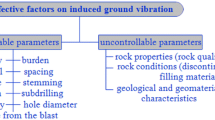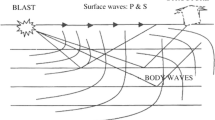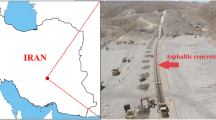Abstract
Blasting is a major component of the construction and mining industries in terms of rock fragmentation and concrete demolition. Blast designers are constantly concerned about flyrock and ground vibration induced by blasting as adverse and unintended effects of explosive usage on the surrounding areas. In recent years, several researches have been done to predict flyrock and ground vibration by means of conventional backpropagation (BP) artificial neural network (ANN). However, the convergence rate of the BP-ANN is relatively slow and solutions can be trapped at local minima. Since particle swarm optimization (PSO) is a robust global search algorithm, it can be used to improve ANNs' performance. In this study, a novel approach of incorporating PSO algorithm with ANN has been proposed to eliminate the limitation of the BP-ANN. This approach was applied to simulate the flyrock distance and peak particle velocity (PPV) induced by blasting. PSO parameters and optimal network architecture were determined using sensitivity analysis and trial and error method, respectively. Finally, a model was selected, and the proposed model was trained and tested using 44 datasets obtained from three granite quarry sites in Malaysia. Each dataset involved ten inputs, including the most influential parameters on flyrock distance and PPV, and two outputs. The results indicate that the proposed method is able to predict flyrock distance and PPV induced by blasting with a high degree of accuracy. Sensitivity analysis was also conducted to determine the influence of each parameter on flyrock distance and PPV. The results show that the powder factor and charge per delay are the most effective parameters on flyrock distance, whereas sub-drilling and charge per delay are the most effective parameters on PPV.












Similar content being viewed by others
References
Adhikari GR (1999) Studies on flyrock at limestone quarries. Rock Mech Rock Eng 32(4):291–301
Adhikari R, Agrawal RK (2011) Effectiveness of PSO based neural network for seasonal time series forecasting. Indian International Conference on Artificial Intelligence (IICAI). Tumkur, India, pp 232–244
Aghajani Bazzazi A, Osanloo M, Azimi Y (2007) Flyrock prediction by multiple regression analysis in Esfordi phosphate mine of Iran. Rock fragmentation by blasting. London Taylor and Francis Group, 649–657
Bajpayee TS, Rehak TR, Mowrey GL, Ingram DK (2004) Blasting injuries in surface mining with emphasis on flyrock and blast area security. J Safety Res 35(1):47–57
Basu D, Sen M (2005) Blast induced ground vibration norms—a critical review. In: National Seminar on Policies Statutes and Legislation in Mines Kharagpur India, 30–31 July 2005, 112–113
Bhandari S (1997) Engineering rock blasting operations. Taylor & Francis, Boca Raton
Bureau of Indian Standard (1973) Criteria for safety and design of structures subjected to underground blast ISI Bull IS-6922.
Davies B, Farmer IW, Attewell PB (1964) Ground vibrations from shallow sub-surface blasts. The Engineer London 553–559
Duvall WI, Petkof B (1959) Spherical propagation of explosion generated strain pulses in rock. USBM Report of Investigation
Fisne A, Kuzu C, Hudaverdi T (2011) Prediction of environmental impacts of quarry blasting operation using fuzzy logic. Environ Monit Assess 174:461–470
Fletcher LR, D’ Andrea DV (1986) Control of flyrock in blasting. Proceedings of 12th Annual Conference on Explosives and blasting technique Atlanta Georgia, 9–14 February. Cleveland, International Society of Explosives Engineers 167–175
Ghasemi E, Amini H, Ataei M, Khalokakaei R (2012) Application of artificial intelligence techniques for predicting the flyrock distance caused by blasting operation. Arab J Geosci doi:10.1007/s12517-012-0703-6
Ghosh A, Daemen JK (1983) A simple new blast vibration predictor. Proceedings of the 24th US symposium on rock mechanics, College Station, Texas 151–161
Hemphill GB (1981) Blasting operations. McGraw-Hill, New York
Holmberg R, Persson G (1976) The effect of stemming on the distance of throw of flyrock in connection with hole diameters. Swedish Detonic Research Foundation Report DS 1, Stockholm
Iphar M, Yavuz M, Ak H (2008) Prediction of ground vibrations resulting from the blasting operations in an open-pit mine by adaptive neuro-fuzzy inference system. Environ Geol 56:97–107
Karadogan A, Kahriman A, Ozer U (2013) A new damage criteria norm for blast-induced ground vibrations in Turkey. Arab J Geosci doi:10.1007/s12517-013-0830-8
Kecojevic V, Radomsky M (2005) Flyrock phenomena and area security in blasting-related accidents. Safety Sci 43:739–750
Kennedy J, Eberhart R (1995) Particle swarm optimization. Proceeding of IEEE International Conference on Neural Networks 1942–1948
Khandelwal M, Singh TN (2005) Prediction of blast induced ground vibration and frequency in opencast mine: a neural network approach. J Sound Vib 289:711–725
Khandelwal M, Singh TN (2007) Evaluation of blast-induced ground vibration predictors. Soil Dyn Earthq Eng 27:116–125
Khandelwal M, Singh TN (2009) Prediction of blast-induced ground vibration using artificial neural network. Int J Rock Mech Min 46:1214–1222
Koop JW (1994) Observation of flyrock of several mines and quarries. Proceeding of 20th Conference on Explosives and Blasting Technique Austin Texas, 30 January–3 February. Cleveland International Society of Explosives Engineers, 75–81
Kosko B (1994) Neural networks and fuzzy systems: a dynamical systems approach to machine intelligence. Prentice Hall, New Delhi
Langefors U, Kihlstrom B (1963) The modern technique of rock blasting. Wiley, New York
Lee Y, Oh SH, Kim MW (1991) The effect of initial weights on premature saturation in back-propagation learning. Proceedings of the International Joint Conference on Neural Networks (IJCNN '91), pp 765–770
Lundborg N, Persson PA, Ladegaard-Pedersen A, Holmberg R (1975) Keeping the lid on flyrock in opencast blasting. Eng Min J 95–100
Lundborg N (1981) The probability of flyrock damages. Swedish Detoni Research Foundation Stockholm DS 5:39
Monjezi M, Bahrami A, Yazdani Varjani A (2010) Simultaneous prediction of fragmentation and flyrock in blasting operation using artificial neural network. Int J Rock Mech Min 47:476–480
Monjezi M, Bahrami A, Yazdian Varjani A, Sayadi AR (2011a) Prediction and controlling of flyrock in blasting operation using artificial neural network. Arab J Geosci 4:421–425. doi:10.1007/s12517-009-0091-8
Monjezi M, Ghafuri kalajahi M, Bahrami A (2011b) Prediction of blast-induced ground vibration using artificial neural networks. Tunn Uudergr Sp Tech 26:46–50
Monjezi M, Amini Khoshalan H, Yazdian Varjani A (2012a) Prediction of flyrock and backbreak in open pit blasting operation: a neurogenetic approach. Arab J Geosci 5(3):441-448. doi:10.1007/s12517-010-0185-3
Monjezi M, Mohamadi HA, Barati B, Khandelwal M (2012b) Application of soft computing in predicting rock fragmentation to reduce environmental blasting side effects. Arab J Geosci doi:10.1007/s12517-012-0770-8
New BM (1986) Ground vibration caused by civil engineering works. Transport and Road Research Laboratory Research Report, 53, 19
Ozer U, Karadogan A, Kahriman A, Aksoy M (2011) Bench blasting design based on site-specific attenuation formula in a quarry. Arab J Geosci 6:711–721. doi:10.1007/s12517-011-0388-2
Pal Roy P (1993) Putting ground vibration predictors into practice. Colliery Guardian 241:63–67
Pal Roy P (2005) Rock blasting effects and operations. Taylor & Francis, Boca Raton
Priddy KL, Keller PE (2005) Artificial neural networks: an introduction. SPIE, Bellingham
Rehak TR, Bajpayee TS, Mowrey GL, Ingram DK (2001) Flyrock issues in blasting. Proceeding of 27th Annual Conference on Explosives and Blasting Technique Orlando Florida, 28–31 January. Cleveland, OH, USA. International Society of Explosives Engineers, 165–175
Rezaei M, Monjezi M, Yazdian Varjani A (2011) Development of a fuzzy model to predict flyrock in surface mining. Safety Sci 49:298–305
Rezaei M, Monjezi M, Moghaddam SG, Farzaneh F (2012) Burden prediction in blasting operation using rock geomechanical properties. Arab J Geosci 5:1031–1037
Roth J.A. (1979) A model for the determination of flyrock range as a function of shot condition. US Department of Commerce NTIS rep no PB81222358, p 61
Shi Y, Eberhart RC (1998) A modified particle swarm optimizer. Proceedings of IEEE International Congress on Evolutionary Computation 69–73
Simpson PK (1990) Artificial neural system—foundation, paradigm application and implementations. Pergamon, New York
Singh DP, Sastry VR (1986) Rock fragmentation by blasting influence of joint filling material. Journal of Explosive Engineering 18–27
Singh TN, Kanchan R, Saigal K, Verma AK (2004) Prediction of P-wave velocity and anisotropic properties of rock using artificial neural networks technique. J Sci Ind Res India 63:32–38
Singh TN, Singh V (2005) An intelligent approach to prediction and control ground vibration in mines. Geotech Geol Eng 23:249–262
Tawadrous AS, Katsabanis PD (2007) Prediction of surface crown pillar stability using artificial neural networks. Int J Numer Anal Met 31(7):917–931
Wiss JF, Linehan PW (1978) Control of vibration and air noise from surface coal mines. US Bureau of Mines Report OFR 103(3):79
Workman JL, Calder PN (1994) Flyrock prediction and control in surface mine blasting. Proceeding of 20th Conference on Explosives and Blasting Technique. Austin, Texas, 30 January–3 February, Cleveland, OH: International Society of Explosives Engineers, 59–74
Yang Y, Zang O (1997) A hierarchical analysis for rock engineering using artificial neural networks. Rock Mech Rock Eng 30:207–222
Author information
Authors and Affiliations
Corresponding author
Rights and permissions
About this article
Cite this article
Armaghani, D.J., Hajihassani, M., Mohamad, E.T. et al. Blasting-induced flyrock and ground vibration prediction through an expert artificial neural network based on particle swarm optimization. Arab J Geosci 7, 5383–5396 (2014). https://doi.org/10.1007/s12517-013-1174-0
Received:
Accepted:
Published:
Issue Date:
DOI: https://doi.org/10.1007/s12517-013-1174-0




